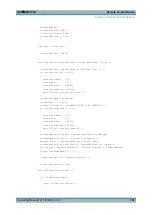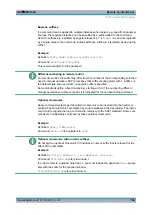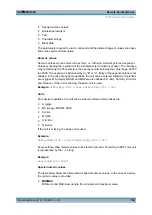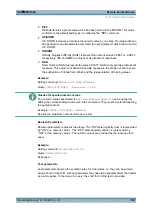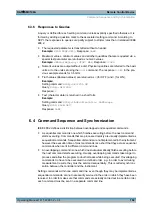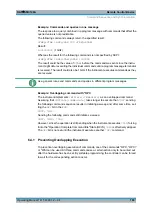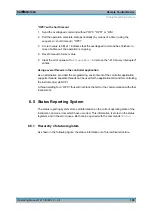
Remote Control Basics
R&S
®
SMC100A
192
Operating Manual 1411.4060.32 ─ 04
6.3.6 Responses to Queries
A query is defined for each setting command unless explicitly specified otherwise. It is
formed by adding a question mark to the associated setting command. According to
SCPI, the responses to queries are partly subject to stricter rules than in standard IEEE
488.2.
●
The requested parameter is transmitted without a header.
Example:
HCOP:PAGE:ORI?
, Response:
LAND
●
Maximum values, minimum values and all other quantities that are requested via a
special text parameter are returned as numeric values.
Example:
SENSe:FREQuency:STOP? MAX
, Response:
3.5E9
●
Numeric values are output without a unit. Physical quantities are referred to the basic
units or to the units set using the
Unit
command. The response
3.5E9
in the pre-
vious example stands for 3.5 GHz.
●
Truth values (Boolean values) are returned as
0
(for OFF) and
1
(for ON).
Example:
Setting command:
HCOPy:DEV:COL ON
Query:
HCOPy:DEV:COL?
Response:
1
●
Text (character data) is returned in a short form.
Example:
Setting command:
HCOPy:PAGE:ORIentation LANDscape
Query:
HCOP:PAGE:ORI?
Response:
LAND
6.4 Command Sequence and Synchronization
IEEE 488.2 defines a distinction between overlapped and sequential commands:
●
A sequential command is one which finishes executing before the next command
starts executing. Commands that are processed quickly are usually implemented as
sequential commands. Sequential commands are not implemented in the instrument,
however the execution time of most commands is so short that they act as sequential
commands when sent in different command lines.
●
An overlapping command is one which does not automatically finish executing before
the next command starts executing. Usually, overlapping commands take longer to
process and allow the program to do other tasks while being executed. If overlapping
commands do have to be executed in a defined order, e.g. in order to avoid wrong
measurement results, they must be serviced sequentially. This is called synchroni-
zation between the controller and the instrument.
Setting commands within one command line, even though they may be implemented as
sequential commands, are not necessarily serviced in the order in which they have been
received. In order to make sure that commands are actually carried out in a certain order,
each command must be sent in a separate command line.
Command Sequence and Synchronization




